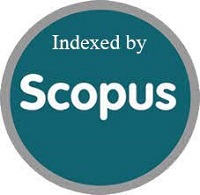Dampak Dari Multidimensionalitas Butir Soal Terhadap Estimasi True Score Dengan Pendekatan Model Bifaktor
DOI:
https://doi.org/10.15408/jp3i.v4i4.9300Keywords:
Model Bifaktor, UnidimensiAbstract
Abstract
Current study is a simulation research, focused on the number of factors, items, and respondents replicated 50 times. After that, replicated data was considered as unidimensional and bifactor and then the effect was computed from theta margin. This research aims to explore the number of factors, items, and respondents, which is measured, affect the unidimensional asumption transgression on bifactor. Also, this research aims to understand bias differences of bifactor data that is considered as unidimensional. The result showed that data with bifactor model and analyzed as unidimensional will obtain the untrue theta score due to high bias differences. In addition, the R square of respondents bias is 0.69%.
Abstrak
Penelitian ini merupakan penelitian simulasi dimana yang menjadi fokus dalam penelitian ini adalah banyaknya faktor, item dan responden dengan replikasi 50 kali. Selanjutnya data hasil replikasi ini dianggap sebagai unidimensi dan bifaktor dan dihitung pengaruhnya dari selisih theta tersebut. Penelitian ini bertujuan untuk dapat mengetahui banyaknya faktor, item dan responden yang ikut terukur berdampak pelanggaran asumsi unidimensi pada bifaktor. Selain itu, juga untuk mengetahui perbedaan bias pada data bifaktor yang dianggap sebagai unidimensi tersebut. Hasil penelitian menunjukkan bahwa data dengan model bifaktor dan dianalisis sebagai unidimensi maka hasilnya akan memperoleh theta yang tidak sebenarnya, karena perbedaan bias atau deviasi yang terjadi cukup tinggi. Disamping berdasarkan hasil perhitungan didapatkan R square sebesar 0.69%, bias responden yang dapat dijelaskan oleh bervariasinya faktor, item dan responden dengan taraf signifikansi 0.000.
References
DAFTAR PUSTAKA
Axelrod, Robert. (2005). Advancing the art of simulation in the social sciences. University of Michigan. USA
Chen, Fang Fang, Yiming Jing, Adele Hayes, Jeong Min Lee. (2013) Two concepts or two approaches: a bifaktor analysis of psychological and subjective well-being. Department of Psychology. University of Dellaware, Wolf Hall, USA.
Chen, Fang Fang, West, Steephen & Sousa, Karen. (2006). A comparison of bifactor and second order models of quality of life. Multivariate Behavioral Research. Lawrence Erlbaum Associates.
Embretson, S. E. & Reise, S. P. (2000). Item response theory for psychologist. New Jersey: Lawrence Erlbaum Associates. Inc.
Fung, C. (2012). Ability estimation under different item parameterization and scoring models. Dissertation, University of North Texas.
Gignac, G. & Watkins, M. (2013). Bifaktor modeling and the estimation of model-based reliability in the WAIS-IV. Multivariate Behavioral Research, 48:39-662. Routledge.
Han & Hambleton. (2007). User’s manual for wingen: windows software that generates irt model parameters and item responses. University of Massachusetts Amherst.
Hambleton, R.K., Swaminathan, H & Rogers, J H. (1991). Fundamentals of item responses theory. California: SAGE Publications.
Hawell, Michael, Stone, Clement, Tse-Chi Hsu & Levent Kirisci (1996) Monte carlo studies in item response theory. University of Pittsburgh. Psychological Measurement vol.20 n0.2, June 1996.
Jenrich, Robert & Bentler, Peter. (2011). Exploratory bi-faktor analysis. National Institute Of Helath Public Access. Jurnal Psychometrika, Oktober 2011.
Kroopnick, Marc Howard. (2010). Exploring unidimensional proficiency classification accuracy from multidimensional data in a vertical scaling context. Disertasi dari University of Maryland, College Park.
Mislevy, R. J & Block, R. D. (1990). BILOG 3: Item analysis and test scoring with binary logistic models. Moorseville: Scientific Software, Inc.
Mundform, D. J., Schaffer, J., Kim, Myoung-Jin, Shaw, D., Thongteeraparp, A., & Supawan, P. (2011). Number of replications required in monte carlo simulation studies: a synthesis of four studies. Journal of Modern Applied Statistical Methods: Vol. 10: Iss. 1, Article 4.
Muthen,& Muthen. (2010). Statistical analysis with latent variables user’s guiden. Los Angeles.
Paxton, Pamela. Et all. (2001). Monte carlo experiments: design and implementation. Structural Equation Modeling. Lawrence Erlbaum Associates, Inc.
Reise, Steven. (2012). The rediscovery of bifaktor measurement models. Journal Multivariate Behavioral Research. Oct. 2012. Vol 47.
Raychaudhuri, Samik (2008). Introduction to monte carlo simulation. Proceedings of the 2008 Winter Simulation Conference. USA.
Retnawati, Heri. (2008). Estimasi efisiensi relatif tes berdasarkan teori respons butir dan teori tes klasik. Disertasi. Yogyakarta: Program Pascasarjana Universitas Negeri Yogyakarta.
Simon, Mayuko Kanada. (2008). Comparison of concurrent and separate multidimensional IRT lingking of item parameters. University of Minnesota. Tesis.
Sinharay, dan Haberman. (2010). Reporting of subscores using muldimensional item response theory. Journal Psikometrika col. 75.no. 2 hal. 209-227.
Seranno, Daniel. (2010). A second order growth model for longitudinal item response data. Disertasi University of Nourth Carolina.
Umar, Jahja. (2012a). Penilaian dan peningkatan mutu pendidikan di indonesia. Ciputat: UIN Press.
Umar, Jahja. (2012b). Mengenal lebih dekat konsep reliabilitas skor tes. Jurnal Pengukuran Psikologi dan Pendidikan Indonesia. April. 2012. Vol.II.
Widhiarso, Wahyu. (2011). Teori pengukuran. Bahan Materi Fakultas Psikologi UGM.



